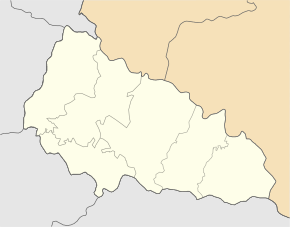Korolewo
| Korolewo | ||
| Королево | ||

|
|
|
| Basic data | ||
|---|---|---|
| Oblast : | Zakarpattia Oblast | |
| Rajon : | Vynohradiv district | |
| Height : | 146 m | |
| Area : | 9.06 km² | |
| Residents : | 8,064 (December 2004) | |
| Population density : | 890 inhabitants per km² | |
| Postcodes : | 90332 | |
| Area code : | +380 3143 | |
| Geographic location : | 48 ° 9 ' N , 23 ° 8' E | |
| KOATUU : | 2121255600 | |
| Administrative structure : | 1 urban-type settlement | |
| Mayor : | Mychajlo Kowach | |
| Address: | вул. Злагоди 13 90332 смт. Королево |
|
| Statistical information | ||
|
|
||
Korolewo (Ukrainian Королево and older Korolewe ; Russian Королёво / Koroljowo , German rarely Königsfeld an der Tisza , Slovak Kráľovo nad Tisou , Hungarian Királyháza ) is an urban-type settlement in western Ukraine ( Transcarpathian Oblast , about 9 kilometers east of the city of Wynohrwyn ) Vynohradiv .
The town with around 8,000 inhabitants (20 percent Hungarian-speaking) is located in the Transcarpathian lowlands to the right, southeast of the bank of the Tisza . The railway station is located south-east of the town center on the Debrecen – Sighetu Marmației railway, while the Batjowo – Korolewo railway branches off to the south . In the Soviet era, the place was an important marshalling yard on the way to the west.
As in many other Transcarpathian towns, there is a Roma camp in Korolewo that can hold over 1000 people.
history
The place was first mentioned in writing as Domus Regalis in 1262 . In 1910 the place in the Kingdom of Hungary in Ung County had 3,167 inhabitants, of which 2,224 were Hungarians and 932 Ruthenians. After the end of the First World War it came to the newly formed Czechoslovakia (as part of the Carpathian Ukraine ) and was ceded to the USSR after the end of the Second World War . On May 30, 1947, the place received the status of an urban-type settlement .
Attractions
- Ruins of the Njalab Castle ( Nyalábvár in Hungarian )
- Roman Catholic church from the 13th century, later rebuilt in baroque style
- Reformed Church from 1911


